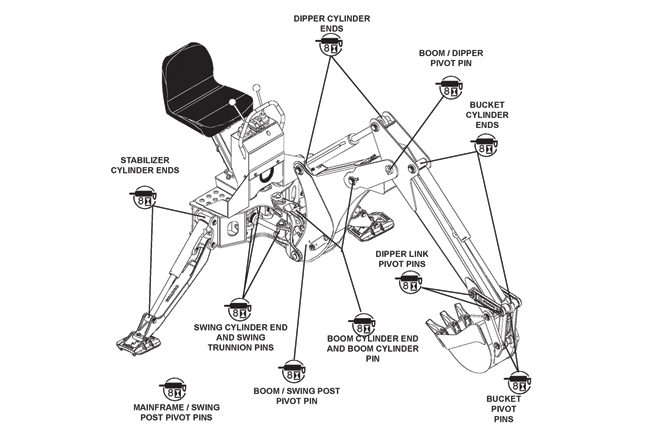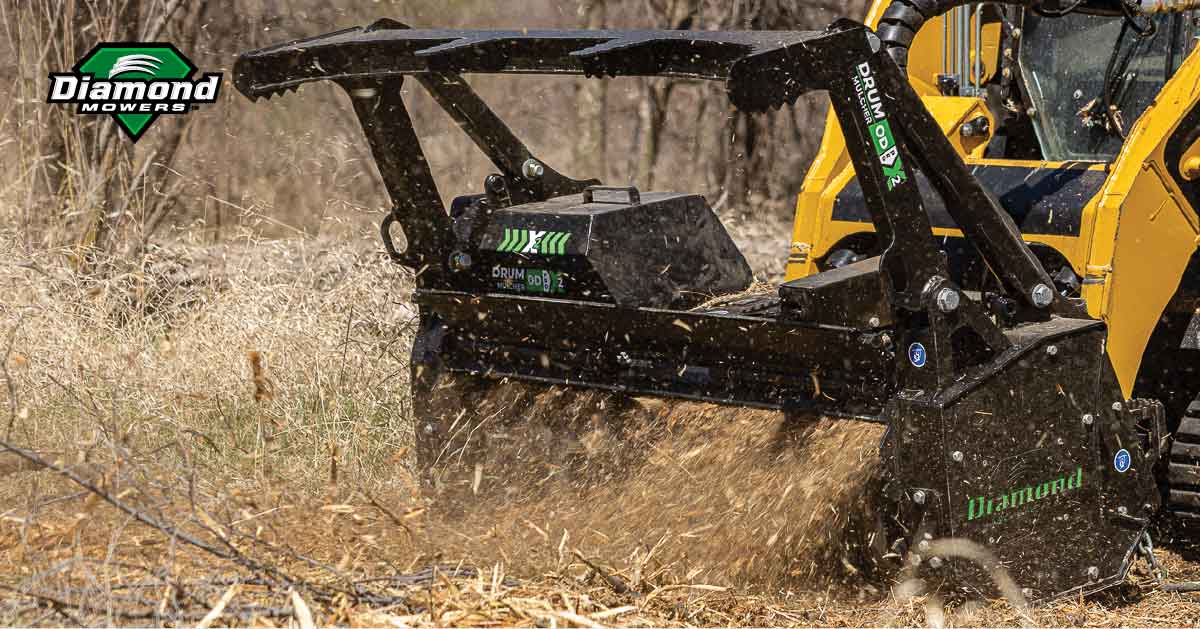Backhoe Attachment Maintenance
Skid steer backhoe attachments save you money over dedicated backhoe or mini excavator machines by increasing your versatility and equipment utilization. Don’t lose those savings to poor attachment maintenance. Here is some expert advice on how to avoid costly repairs and keep your attachment performing to its full potential through daily inspections and routine maintenance.
Grease Is the Word
Backhoe attachments have several pivot points — swing, boom, dipper, bucket, etc. — that all need lubricated on a regular basis to ensure smooth and efficient operation. For its Bradco backhoe attachments, Paladin Attachments strongly recommends that you lubricate all parts provided with grease fittings daily or every 8 hours, whichever comes first, with SAE multi-purpose lubricant or an equivalent SAE multi-purpose grease.

“Failing to routinely grease your backhoe attachment’s moving parts reduces efficiency, causes excessive wear and often requires you to purchase expensive replacement parts,” says Dave Aldrich, light construction dealer development and service manager for Paladin Attachments. “For example, failing to lubricate pins and bushings routinely will cause them to wear prematurely, resulting in housing damage which is a costly fix at upwards of $2,000.”
In contrast, it is also very important to avoid excessive greasing. Dirt collects on exposed grease and greatly increases wear. Be sure to wipe off excess grease from all fittings after greasing to reduce this wear.
Walk the Walk
Conduct daily walk-around inspections to check for problems that can be made worse if not attended to. Clean equipment of all dirt, oil and excess grease to help you avoid overlooking worn or damaged components. Once clean:
- Check to see that all pins are secured with a bolt or snap.
- Inspect all cylinders to be sure there is no oil seepage around the hoses, valves or filling tube entrance.
- Make sure the hose routing is not rubbing or being pinched when the backhoe is being transported or operated and while in a folded or fully extended position.
- Look for dirt that may be caught between the stabilizer arms and cylinders, and make sure no rocks or dirt are damaging the pivot areas.
- Check the mounting system to make sure there are no loose nuts or bolts.
- Examine bucket teeth for wear and replace and tighten where necessary.
- Inspect the bucket and entire attachment to make sure there are no cracks.
Oil … Hydraulic Oil That Is
Because backhoe attachments utilize a number of moving parts, it is crucial to check the hydraulic oil level on your skid steer at least once every 40 hours of operation. It is also very important to check the oil levels when switching between attachments because different attachments may require different oil levels. Warning: Hydraulic oil is under pressure and may be hot. Escaping hydraulic fluid under pressure can penetrate your skin, causing serious injury. Stop your skid steer engine and relieve pressure before connecting or disconnecting lines and consult your manufacturer’s backhoe operation manual for additional safety precautions before proceeding.
To check the hydraulic oil levels, first ensure that your backhoe attachment is securely attached to your skid steer. Once attached, place your backhoe attachment in the transport position. This will extend some cylinders and close others, helping to even out oil levels and create an average oil displacement. If oil is low, check all lines, fittings and the control valve for signs of leakage. Failure to maintain your skid steer’s hydraulic oil supply can cause serious problems with your backhoe attachment. Below are some common issues you may experience, their possible causes and how to remedy them.
Take Care of Your Teeth
An easy way to avoid unnecessary maintenance costs is to regularly inspect your backhoe attachment’s bucket teeth. Larger backhoe attachments use pin-teeth, while smaller buckets have bolt-on teeth. Most backhoe attachment bucket teeth, including those in the Bradco line of backhoe attachments, are self-sharpening, however, they should be replaced when they become worn or broken. Regularly inspect bucket teeth to make sure they are sharp. When they begin to dull, it is important that you replace them immediately. Dull teeth put more force on the bucket shank because the teeth can no longer cut through the ground with ease. If the shank becomes worn, it is much more expensive to replace than teeth, so inspect them often and replace at the first sign of dullness or reduced digging performance.

“Finally, one of the most important things to remember when purchasing any kind of attachment is to match it with your skid steer’s operating capabilities,” says Aldrich. “Buying a backhoe attachment that is too big for your skid steer can put undue stress on the machine, causing it to wear faster and cost you thousands in unnecessary maintenance.”
As always, read your backhoe attachment manufacturer’s operation manual thoroughly before use. The operation manual also commonly includes troubleshooting tips in case problems occur. Contact your local dealer or manufacturer with any questions to make sure you get the best performance possible out of your backhoe attachment.
John Thomas is the vice president of marketing and business development for Paladin Attachments, which includes Bradco backhoe attachments, based in Dexter, Mich.




